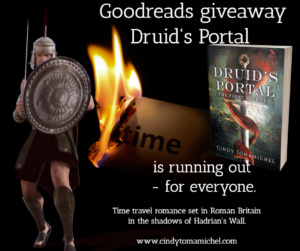Cindy Tomamichel's Blog: World Building, page 6
February 22, 2019
Making a hero
Often we read to escape- but sometimes we find ourselves. In genre fiction, the novels of science fiction, fantasy and historical authors build a world where readers can travel to imaginary worlds, marvel and be lost to the present day. But a book can be so much more. It can be a place where someone who needs a dream – some hope – can find it. So what does the physical appearance of your characters say to the reader?
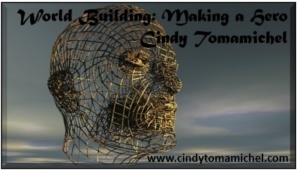
This is a tough call. Hollywood movies and the cult of the celebrity all worship at the altar of extreme beauty, of washboard abdominals and electric blue eyes. Magazines offer articles on how one can resemble someone who is as beautiful as a god. In a world as deep as a photo, a pretty face is bankable, enviable, adored. That’s not a bad thing – actors spend hours perfection their genetic blessings, and come up a treat. I won’t deny the benefits of a hour of eye candy on the screen.
But what of the rest of the world? Working in rotten jobs, sitting on a school bus, endlessly house cleaning? Watching their hands become gnarled with age, and the wrinkles deepen? Or starting out with problems they cannot fix? Don’t they deserve a dream where someone just like them saves the world? Let them open a secret door and find magic.
A real world hero is a complicated beast. A past that might have left scars. A present perhaps afflicted with medical issues. A future where injuries do not magically disappear.
Science fiction offers the opportunity for perfection – advanced surgery to achieve the body of a god. But this doesn’t have to be the route you take. Heinlein in “The Moon is a Harsh Mistress” had the main character missing an arm, the result of an accident. Andre Norton often had the space traders beset by plagues and boils. Harry Harrison in his “Bill, The Galactic Hero” series had Bill the victim of military surgery that resulted in two right hands of different colours, and at one stage, a leg that ended in a claw. Doctor Who has been an epic series where the companions are ordinary people in an extraordinary situation.
Fantasy offers a complex canvas to explore the concept of inclusion. Wars, plagues and quests are all times when injuries happen, and cannot be fixed with primitive medical or magical healing. Some interesting consequences of healing come up in the scarring of Jondalar in Jean Auel’s “Clan of the Cave Bear” where Jondalar who himself is quite beauty conscious, becomes scarred. Another is “Last of the Renshai” by Mickey Zucker Reichert, where the main character becomes a paraplegic. For people who have seen “King Solomon’s Mines” with the gorgeous Stewart Granger or Richard Chamberlain in the main role, it is worth reading the book by Henry Rider Haggard. The original hero is a short, older man with hair that he refers to as like a scrubbing brush.
Historical fiction has a wonderful advantage in research. The effects of battle, the pox, poor nutrition, industrial accidents and all sorts of things can be included. Victorian times were an era of poisonous cosmetics, of adulterated food, and multiple childbirths. Even in regency novels, often plagued by hauntingly beautiful women fawning over a man in tight breeches can make good use of a hero with some issues. The novel “The Captain’s Wallflower” by Audrey Harrison has a captain returning to society, after having lost his sight in a battle at sea. The novel “The Name of the Rose” by Umberto Eco has scarcely a comely character from beginning to end. The Brother Cadfael series by Ellis Peters often juxtaposes beauty beside – and sometimes in spite of – hideous maladies.
But there are some that combine a handsome hero with scars that mark their journey through the events that made them what they are. Tarzan by Edgar Rice Burroughs, was described by Jane as having “a godlike exterior” but had many scars, with a noticeable one that ran across his forehead, and became a red band when enraged. More recently, the Netflix series “Arrow” has the hero Oliver Queen adorned with a mosaic of scars and tattoos, a reminder of the harsh process of turning a useless pretty boy into a vigilante hero.
But even heroes, no matter what their external appearance, are people. People with a past, and an uncertain future – depending on the sort of novel. An ordinary person becomes beautiful in the eyes of love. A person steps up and does the job that no one else is willing to do – and that is the mark of a hero. They may be saving the universe, or saving a dog from traffic, but to the reader, they will be someone to admire because of who they are and what they do, not what they look like.
Inside every reader lies a hero in waiting.
P.S. Druid’s Portal : The Second Journey is due out May 22 with Soul Mate publishing.
If you are a writer, I have a book “The Organized Author” coming out in April with Rhetoric Askew.
Enjoy this blog? Have a think about signing up via my website or catch them as they fly around the ether on twitter or facebook . They will stay where they are pinned on pinterest .
For those that have not read Druid’s Portal yet, here is a link to the first chapter DruidsPortal
Scifi more your thing? Try my short stories in the anthologies Quantum Soul and Tales from Alternate Earths 2.
If you are keen to chat with other scifi peeps, then check out the Knights of the Scifi Roundtable facebook group and subscribe to their newsletter https://mailchi.mp/29fb30bca8e4/update-subscription
Short stories and poetry? Try the Rhetoric Askew anthologies: Mixed genre, Adventure or Romance
Tired from all that thinking? Try a 5 Minute Vacation! 5 Minute Vacation
The post Making a hero appeared first on Cindy Tomamichel.
January 23, 2019
World building: Downtime
Summer holidays last forever, especially if you are a child – or indeed a parent.
Weeks and weeks of sun drenched days with no planned activities. Sounds marvelous? But how are these to read about? Endless descriptions of sunsets or fishing or lolling about watching Netflix gets dull real fast.
So how do you handle it in your novel?
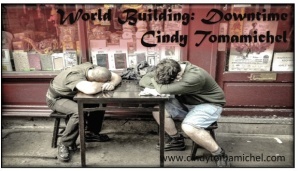
For the most part, people seem to manage it by frenetic activity – particularly high action adventure, such as Matthew Reilly. His heroes never eat, and only rest when they are dead. The plot drags you along relentlessly, and you flip pages, breathless with excitement. Many quest novels are the same, with very little downtime, or a chance for the all important second breakfast. There is always a monster just around the corner, and the questors hurl themselves forward with seemingly inexhaustible energy, and no need for toilet breaks.
And yet by the end of a high action novel, do you feel you know the characters? Did they survive long enough to gain some depth and back story, or are you forced to read several books in the series, desperate for the two lines of back story tidbits? These are extreme examples of plot driven novels, and usually make for exciting reading. They would most likely translate well into a movie, where internal dialogue is not wanted.
There are a few ways to add character depth as they hurtle through the plot. Andy McDermott in his Nina and Eddie archaeology adventure series does it with jokes and side quips during the action. At the end of a car battle, we know Eddie as he remembers his past, wise cracks with the bad guys, and rescues his wife, or is rescued by her. Another is a very brief introduction before the action. An old army buddy will open up a bit of the past, which will have an unexpected impact on the battle, and then the book.
Tag lines are another way. If a character repeats a phrase, or a physical gesture, then they are more easily remembered.
A series that manages high action quiet times is the Modesty Blaise series by Peter O’Donnell. During a caper, waiting for the bad guys to arrive, Modesty and Willie Garvin swap stories, and play verbal games. These endearing sections make the novels much more than mere crime action novels, as good as the action is.
A common fantasy ruse is the meal, and Tolkien uses party meals, Elven feasts, and prison meals as a way to highlight characters and species. Without ever seeing an orc, we know how nasty they are from their favourite foods. Gollum reaches new depths of awfulness and despair when he is forced to eat goblins in the depths of the caves. Compare this to the relief when they are safe at Beorn’s house, eating a simple meal of bread and honey. But they learn much during this meal, and gain a powerful ally.
Sci-fi down times are interesting, as they can highlight a lot of world building and what is normal and what is not. In the vast distances of space – is the time handled with deep sleep, multi generational ships, or busy work for shifts of people? What cultures develop as a result? In the second (and arguably the greatest) Aliens movie, the early awakening of the military and crew, exercise, and jokes shared by the crew sets the scene for their comradeship and teamwork when under threat. By the time the aliens pop up, we care about the human crew. If we went straight into the action, then it is a faceless bloodbath.
In “The Watch Below” by James White, the crew are trapped in a submerged vessel, and for generations, confined with little to do but exercise their minds and memories. This develops into an extraordinary culture where fictional characters and stories become a primary stabilising factor. This is contrasted to an alien multi generational ship, which suffers bloody battles and cultural degeneration. So downtime here was almost all there was, and White uses it as a tool that shapes the evolving culture. My story “When Words are not Enough” in Quantum Soul was influenced by this idea of multi generational confinement.
Downtime in a novel is also a good time for the reader to have a little break, to gear up for the next part. Let the reader into the placid or quietly fascinating parts of your world, and they will care more about your characters when they face an even greater danger, lurking while they relaxed, just out of sight…
Enjoy this blog? Have a think about signing up via my website or catch them as they fly around the ether on twitter or facebook . They will stay where they are pinned on pinterest .
For those that have not read Druid’s Portal yet, here is a link to the first chapter DruidsPortal
Scifi more your thing? Try my short stories in the anthologies Quantum Soul and Tales from Alternate Earths 2.
If you are keen to chat with other scifi peeps, then check out the Knights of the Scifi Roundtable facebook group and subscribe to their newsletter https://mailchi.mp/29fb30bca8e4/update-subscription
Short stories and poetry? Try the Rhetoric Askew anthologies: Mixed genre, Adventure or Romance
Tired from all that thinking? Try a 5 Minute Vacation: 5 Minute Vacation
The post World building: Downtime appeared first on Cindy Tomamichel.
December 22, 2018
Time travel, scifi and 2018
How was 2018 for you? I hope it was a year when you got some things done, and enjoyed the process. I thought instead of more world building at a time of year when everyone is too inebriated/tired/shopped out, I’ll just update on my writing. As a present for reading, I have attached a link to a short story – a fractured fairy tale. I asked myself what happens to Rapunzel if her Prince never finds her?
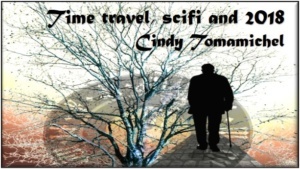
Time Travel Romance
Druid’s Portal : The Second Journey will be published in May 2019. Follow the adventures of Ethan, the son of roman soldier Trajan and archaeologist Janet as he also faces his duties as guardian of the Arwen pendant. What happens if he doesn’t believe in time travel?
I am currently writing the Third Journey, which promises to be a three book epic of the third generation to travel through time. No more spoilers – although in this one, mysteries from the first journey will be revealed!
I have also started a new series of short stories – Renaissance Faire. The stories are of women who travel in time to fulfill a secret wish. But with magic – sometimes you get what you need rather than what you want. I hope to self-publish this in the first half of 2019.
Science fiction
I have a short story in the anthology Tales from Alternate Earths 2. The collection has been popular, and I am very proud to be associated with some award winning authors.
I am also a member of an awesome Facebook group, Knights of the Scifi Roundtable. Check out their newsletter, and subscribe for news about new and free scifi and fantasy books and blogs. Click here.
Self Help
Five Minute Vacations was released this year – and is still an ideal Christmas present for people wanting a few moments of stress relief. Free review copies are available on Booksprout.
The Organised Author: I have a contract with Rhetoric Askew to publish a book which is designed to help beginner authors and writers establish their author platform. Associated with this will be an email course with additional material not in the book, and instructional videos. Stay tuned, but expect an April release!
If you would like to review a pre release copy for free, please follow me on Booksprout. https://booksprout.co/author/3852/cindy-tomamichel
Anyway, I hope you enjoy the story, and have a great time with loved ones over the holiday period.
Short story link: The Crone’s Fairytale click here
Enjoy this blog? Have a think about signing up via my website or catch them as they fly around the ether on twitter or facebook . They will stay where they are pinned on pinterest .
For those that have not read Druid’s Portal yet, here is a link to the first chapter DruidsPortal
Scifi more your thing? Try my short stories in the anthologies Quantum Soul and Tales from Alternate Earths 2.
Short stories and poetry? Try the Rhetoric Askew anthologies: Mixed genre, Adventure or Romance
Tired from all that thinking? Try a 5 Minute Vacation! 5 Minute Vacation
The post Time travel, scifi and 2018 appeared first on Cindy Tomamichel.
November 22, 2018
World building: Celebrations
Woo who – lets have a party! Said every human in every culture since the dawn of time. There are more festivals and things to celebrate than there are days in the year, so the human race is definitely one that likes to kick back and enjoy food, drink, each other or their deity of choice. It is an ideal way to see a culture at it’s most relaxed, or sometimes at its most formal, depending on the occasion. What will a festival say about the world you have created?
 Festivals or celebrations often have an agricultural/seasonal basis, when the end of winter, mid summer, New Year, etc are heralded with some relief by a population starved for entertainment, and possibly also food. Imagine the arrival of Spring after a long winter when you were down to eating your boots! The first fresh flowers and green foods would have been a welcome sight, and perhaps also a life saving one. Foods that first appear, or are bountiful in harvest times are often celebrated – look at the massive pumpkin frenzy around Fall in the USA. But holidays around the world commemorate such things as oysters, the first box of cherries, mangoes, wine – you name it, it is probably cherished somewhere.
Festivals or celebrations often have an agricultural/seasonal basis, when the end of winter, mid summer, New Year, etc are heralded with some relief by a population starved for entertainment, and possibly also food. Imagine the arrival of Spring after a long winter when you were down to eating your boots! The first fresh flowers and green foods would have been a welcome sight, and perhaps also a life saving one. Foods that first appear, or are bountiful in harvest times are often celebrated – look at the massive pumpkin frenzy around Fall in the USA. But holidays around the world commemorate such things as oysters, the first box of cherries, mangoes, wine – you name it, it is probably cherished somewhere.
Often books written by authors reflect something they yearn for, or have missed. Here we see Enid Blyton, Tolkien and CS Lewis writing after terrible wars and food rationing. Their books are filled with delightful midnight feasts, elven bread, hobbit second breakfasts and royal dinners. JK Rowling also follows this fine tradition with many eating scenes and celebrations throughout – until they are searching for horcruxes, when food deprivation and missing Christmas are some of the many trials Harry, Hermione and Ron must face.
Seasonal celebrations are usually linked with celestial change- the longest or shortest day or solstice – Beltane, Samhain and Yule for example. These are often very old celebrations, and have a long history of special foods and rituals. Quite often they have been so entrenched in the culture that we celebrate them today, renamed in more recent religions. To measure the days and mark the time to party, elaborate calendars such as stone circles have been invented. Certainly a celebration would take on a mystical quality with the first rays of sun through a stone portal, and all know it heralds the end of the cold.
So, historical authors can have some fun researching foods, drink and rituals, including as many as they wish. One interesting thing would be the impact of a holiday on a person. Are they home with family and is it all familiar? Or in a foreign land, their stomach rumbling from unaccustomed food, and secretly horrified (or excited) by what they see? How will they react? One of the Man From UNCLE series had a spy chasing and being chased through a masked street festival, with the costumes adding an element of surprise, danger and disguise, forcing the main character to think quickly.
Fantasy authors can also throw themselves into researching pagan festivals and the types of food, activities (fertility rituals anyone?). Will the festival be a welcome relief? A derailment of their quest? A danger as some become drunk and get arrested? Will someone end up married or pregnant? A festival can add a totally random and fun element to a story, spinning it off into a fresh path, while at the same time providing a great deal of depth to the world you have created.
Scifi authors can also invent new celebrations, or rehash old ones. Heinlein makes a great deal of Fat Tuesday, with it becoming Carolita’s day, celebrated throughout the galaxy in “Time Enough for Love”. Take one of the current craze for national day of something and make it your own. What about alien celebrations? A long forgotten story was a first encounter, where the humans thought they were celebrating an alien religious festival, finding out – too late – that they were on the menu. An old theme, even used by CS Lewis in “The Silver Chair” Narnia series.
A more sedate reason for a celebration or commemoration is to mark a military victory or loss, or the end of wars, or the first arrival in a new country. This can be a more solemn, formal occasion where people are more likely to show private grief and loss in public. This could be a good time to fill in some back story that won’t fit in elsewhere.
So, humans like to party, regardless of the time, place or reason. A way to forget for a space the short time we are in this universe, and join hands (or other body parts) with another human while we can. Party on dudes!
Enjoy this blog? Have a think about signing up via my website or catch them as they fly around the ether on twitter or facebook . They will stay where they are pinned on pinterest .
For those that have not read Druid’s Portal yet, here is a link to the first chapter DruidsPortal
Scifi more your thing? Try my short stories in the anthologies Quantum Soul and Tales from Alternate Earths 2.
Short stories and poetry? Try the Rhetoric Askew anthologies: Mixed genre, Adventure or Romance
Tired from all that thinking? Try a 5 Minute Vacation! 5 Minute Vacation
The post World building: Celebrations appeared first on Cindy Tomamichel.
October 22, 2018
World building: Are we there yet?
People have been making up ways to measure and define all the things for a very long time, perhaps longer than we can measure. So if in “real” life people make up stuff that becomes a standard, what shall we do in a fictional world? Stick to tradition or make up some wacky system ourselves?
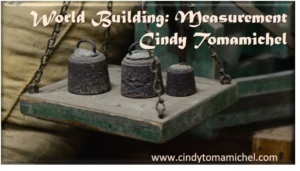 The earliest forms of measurements were used by the Mesopotamians in around the 4000BC mark. So, some 6,000 years ago people were arguing about what weight of grains they bought and sold. Roman weights and measures have been found that have been modified to give false measurements for goods.
The earliest forms of measurements were used by the Mesopotamians in around the 4000BC mark. So, some 6,000 years ago people were arguing about what weight of grains they bought and sold. Roman weights and measures have been found that have been modified to give false measurements for goods.
But what about even earlier? Would a cave dweller need to measure things? The distance it takes to walk to a destination, how big to build a shelter, or the right amount of herbs in a potion. All these require reasonable accuracy, and the nearest thing available was the human body. Hence, measurements in feet, a handspan, a fingers breadth, a pinch. This sort of measurement system is one readily adopted for fantasy writing. A rough estimate of a days ride for a horse may be quite adequate for the reader. Jean Auel in her Earth Children series had a section where she discussed that some people could not read a map scratched on a flat bone, and that distances themselves varied between walking and horse riding. Places became closer when humans moved faster. So even the perception of landscape changed with different forms of transport. Even today, the idea of being in one country for breakfast and another for dinner seems unreal.
So a rough system of measurement based on the human body seems adequate for fantasy. If the author makes up something complicated it can distract from the story unless it is important. There are plenty of archaic and quaint systems to use, including such measures as a cow’s grass, cubits, chains or the imperial system. Here is a list https://en.wikipedia.org/wiki/List_of_unusual_units_of_measurement
For historical authors, research is the only way to figure it out for your time period, unless you avoid it altogether. But it can play an important part – will it the heroine get to the city in time to rescue the dashing aristocrat from the guillotine? In a time travelling DeLorean yes – but a donkey cart, well, she will be settling for a handsome sweaty farm hand instead. I was slightly interested to find out the metric system has been in use since the 1700’s, but not uniformly adopted. So research is key to getting it right, particularly the words used. Apothecary weights anyone?
But venturing into scifi it becomes far more technical. Which should not be confused with interesting, as I suspect there are few readers that interested in detailed calculations of made up units, based on six moons circling a black hole or something. Heinlein managed to squeeze in some equations in a few of his novels, but they were at least based on our solar system. While I never checked, there would be readers that did, and so accuracy is important if you are going to include math and calculations. Asimov and his story “Nightfall” is probably one of the most compelling ideas based on celestial timing. Well worth checking out.
The measurements of space already sound wonderfully futuristic – light years for instance. Depending on your type of scifi, the depth of tech detail will vary. Writers of hard scifi will know their readers expect technical accuracy, whereas softer forms of scifi can get away with a bit of handwavium action. A good rule of thumb – and this goes for all fiction – if you don’t know, either find out, or leave it out.
What is important is to pick a standard and stick to it. Don’t be walking clicks one page and miles the next. This even causes problems in real life, with space and airline disasters arising from a mismatch of units. Walk a while in another person’s shoes – but will they be imperial or metric?
Enjoy this blog? Have a think about signing up via my website or catch them as they fly around the ether on twitter or facebook . They will stay where they are pinned on pinterest .
For those that have not read Druid’s Portal yet, here is a link to the first chapter DruidsPortal
Scifi more your thing? Try my short stories in the anthologies Quantum Soul and Tales from Alternate Earths 2.
Short stories and poetry? Try the Rhetoric Askew anthologies: Mixed genre, Adventure or Romance
Tired from all that thinking? Try a 5 Minute Vacation! 5 Minute Vacation
The post World building: Are we there yet? appeared first on Cindy Tomamichel.
September 22, 2018
Worldbuilding: Touch what?
If a smell can trigger a memory, then a touch can trigger an immediate reaction. Our vocabulary is rich in words that are repellent merely from their association with touch – moist slithers to mind. But the opposite is true – words like caress can conjure romance, magic and more. The anticipation of touch can be even worse – does the reader know what is in store for the character?
I’ll start with anticipation, for there lies the madness of will he/won’t she? Movies perhaps show this well, for instance the floor of broken glass Bruce Willis must travel over in bare feet in Die Hard 2. The universal cringe of actor and audience when he realises what’s ahead – and that heroic moment when he takes that first step. There is a lot of power in that decision – another sort of character may step away from the task. But it can also be anticipation of the unknown. Here, the scene in Flash Gordon where they had to put their hands in a hollow tree filled with poisonous creatures as a test of bravery. The tunnel scene in Indiana Jones 2, where she had to put her hand into mucus and face crawling insects to reach her prize. I challenge anyone not to squirm watching that scene.
So from those scenes, you can develop your character from their reactions and fears. Will they face a fear? Or faint and need rescuing? Has the author foreshadowed it enough so there is a delicious sense of anticipation when the character does have to face the horror?
Or is it a surprise? The blob of mucus (there is that word again) dripping from the jaws of a dinosaur onto a boys head and their slow looking up into the face of terror, from Journey to the Centre of the Earth (Brendan Fraser version). Will there be instant death (Jurassic Park style) or adventure or even a moment of trans species communication? Heinlein in ‘StarBeast’ and Norton in ‘The Zero Stone’ handle this sort of encounter well. A more recent example is SE Sasaki and her excellent Grace series, (“Grace and Bud” series (https://www.amazon.com/S.E.-Sasaki/e/B01775X0UW/) with the awesome plant thing.
But let us return to repellent touch. A quick and dirty search reveals the word moist is repellent due to its association with bodily functions we generally avoid, and also because the face you make when you say it triggers a level of disgust. Or it could be just an internet phase. In general however, things that make you shiver – cold, damp, slime, or are repulsive and associated with sickness – vomit, mucus, phlegm, are going to be great images to use. RE Howard was a big user of the slithery slimy unseen thing in the darkness. But think also the dripping acid slime in Aliens – that never failed to make viewers anticipate something baaad was going to happen.
A warm touch is more of a fever association, and this too can give a warning of danger, of illness and plague. Or something worse – in the Hornblower series (CS Forester) he rests his hand on the forehead of his restless firstborn, and feels lumps, like small shot pellets under the skin. Knowledge is his – the child has smallpox – and we are drawn into the world of pain when he realises he is helpless to prevent his child dying.
But moving on, it is not all gruesome and full of yuck. A feathery caress from an unacknowledged love, the merest brush of fingertips and the world has shrunk down to the intensity of first love, of a passion that blinkers us to the rest of the world. Yet the two characters quiver with a passion that they must restrain, must contain, and above all not reveal to the rest of the world. What will be the difference in later years – will the burning of first love die into blows? Or the brush of dry lips on a cold cheek? Will they compensate with the soft skin of a child, or the comforting coldness of a glass of ale? Or will the love continue into old age, with the caress noticing the softness of skin fallen into wrinkles, but still beloved?
Touch is such an important part of being human that it is said your lifespan is shortened by its lack. So use it well in writing, for it is a powerful way to touch the very heart of your reader.
Enjoy this blog? Have a think about signing up via my website or catch them as they fly around the ether on twitter or facebook . They will stay where they are pinned on pinterest .
For those that have not read Druid’s Portal yet, here is a link to the first chapter DruidsPortal
Scifi more your thing? Try my short stories in the anthologies Quantum Souland Tales from Alternate Earths 2.
Tired from all that thinking? Try a 5 Minute Vacation! myBook.to/5MinVacation
The post Worldbuilding: Touch what? appeared first on Cindy Tomamichel.
August 22, 2018
Twisted History
The sub genre that is Alternate History has – naturally – an illustrious history! But what is it? I’ll quote the wiki entry on the definition:
“The Collins English Dictionary defines alternative history as “a genre of fiction in which the author speculates on how the course of history might have been altered if a particular historical event had had a different outcome.” (https://en.wikipedia.org/wiki/Alterna...)
So it is the ultimate “What If?” fiction. The earliest fiction in the genre – sometime around 9BC – was Livy, wondering on the outcome of Rome fighting Alexander the Great (spoiler alert: Rome won). The stories continued during the Middle Ages with authors speculating on the ability of God to change events, to epic romances set in the Crusades.
But it wasn’t until the development of science fiction in the late 1800’s that the genre really took off, with some famous authors such as Nathaniel Hawthorne dabbling in the genre. H.G. Wells was almost a certainty to write something, and the “Men Like Gods” brings in the concept of alternate universes. Even Winston Churchill gave us the short story “If Lee Had Not Won the Battle of Gettysburg.”
The 20th century provided a wealth of topics for the genre. World wars, dictators, science and warfare inventions – all these are hearty fare for the What If questioners. It was during this time that the genre broadened to include parallel or alternate universes and time travel. Robert Heinlein covered these in “The Number of the Beast” and “The Cat Who Walked Through Walls.” Modern authors Harry Turtledove, L. Sprague de Camp, Phillip K. Dick, and Harry Harrison continue to expand the genre into new realms.
But to be a decent read, a story needs more than a What If?
“According to Steven H Silver, an American science fiction editor, alternate history requires three things:
a point of diverergence from the history of our world prior to the time at which the author is writing,
a change that would alter history as it is known,
and an examination of the ramifications of that change.” (https://en.wikipedia.org/wiki/Alternate_history)
It is an area of interest to me, as Druid’s Portal: The Second Journey explores alternate history and the consequences of choice. As a teaser, my What If? was: What would happen if a man who knew the past could change it all? An action packed adventure in Celtic Britain, where Rome suffered a catastrophic early defeat. It is due to be published next year!
So – champing at the bit to read some alternate history? Of course you are! This is your lucky day.
I am pleased to be part of the successor to the Sidewise Award winning Tales From Alternate Earths anthology.
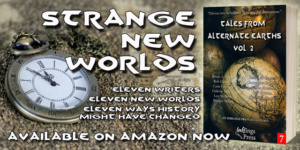 Step into the worlds that might have been, the worlds of alternate history where
Step into the worlds that might have been, the worlds of alternate history where
– climate change plunges the Earth into a frozen landscape,
– the Moon landings may not have happened the way they did in our world,
– a 10th century polymath invents the glider and changes the world,
– Jacques Cousteau’s successors create an undersea city,
– Soviet astronauts are feted as heroes as they lead the way in space,
– time travel runs wild,
– fairy beings tiptoe into reality.
All this and more. There are Americas of a different tilt, an alternate path steering away from world war, and nations where the most dangerous thing is knowledge.
Authors Jessica Holmes, Daniel M. Bensen, Rob Edwards, Leo McBride, Christopher Edwards, Gideon Marcus, Casia Courtier, Jeff Provine, Cindy Tomamichel, Brent A. Harris and Bonnie Milani show us the world that might have been – if the world had taken a different path.
This is the seventh anthology from Inklings Press, dedicated to opening the door into different worlds, with a foreword by Sidewise Award winner Daniel M. Bensen.
The universal link for the anthology is: mybook.to/AlternateEarths2
My story “The Dust in the King’s Library” involves time travel, parallel universes and the rare ability to make a good cup of tea. You can read an excerpt from it (and a teaser from the story by Brent A. Harris) here:
https://workingtitleblogspot.wordpress.com/2018/07/25/coming-soon/
Enjoy this blog? Have a think about signing up via my website or catch them as they fly around the ether on twitter or facebook . They will stay where they are pinned on pinterest .
For those that have not read Druid’s Portal yet, here is a link to the first chapter DruidsPortal
Tired from all that thinking? Try a 5 Minute Vacation! myBook.to/5MinVacation
The post Twisted History appeared first on Cindy Tomamichel.
August 14, 2018
New book excitement
So today I'd like to let people know I am a part of the anthology "Tales From Alternate Earths 2: Ten new broadcasts from parallel dimensions
The first volume had two stories nominated in the Sideways Award, with one winner. This is an award for Alternate History. So if the "What If's" of history always sparked your imagination, these short stories are for you.
My story "The Dust In the King's Library" starts with wondering What if King George was sane? His was a tumultuous time, the French Revolution, The American War of Independence, and he was a supporter of science and technology.
"What if there was a way to talk to those now dust?" What indeed!
Check it out, tell your friends and feel free (of course!) to share the news.
July 22, 2018
Writing News
Been wondering what I have been up too? Well, probably not, but as I am still alive and squirreled away in my study, I thought an update might well be of some interest.
Druid’s Portal: The First Journey has reached the magical target of ten Amazon reviews, which is lovely and much appreciated. In some exciting news, I have a Goodreads giveaway running this month, so if you are on Goodreads, click on this link, and sign up for the chance to win a paperback! Of course, you are welcome to buy it anyway if you are not willing to wait.
Druid’s Portal: The Second Journey is currently with my lovely Soul Mate Publishing Editor Sharon Roe, and I hope that it will get published before the end of the year. It follows the next generation into the time portal, and events set in motion in the first cause havoc in the second. I have delved into a lot of alternate history, and characters that Janet and Trajan met have had some quite different lives.
Druid’s Portal :The Third Journey will wrap up the series. I am researching it now, and it is full on action and adventure, using several key historical events and people.
Anthology: In other writing projects, I have a short story coming out (July 27) in “Tales from an Alternate Earth 2”. It is a collection of short stories focusing on alternate history, and mine ‘The Dust in the Kings Library’ is a twist on King George and his use of toxic cosmetics. I highly recommend the first Alternate Earths collection as well. Click here to check it out.
Short story collections: I am going to release my short stories on an unsuspecting world. If you enjoy scifi, or speculative fiction or romance, there will be something I hope will be of interest. These are being edited at the moment, but I expect to have them done by the end of the year.
So lots of things to look forward too, and quite a few projects to keep me busy!
Enjoy this blog? Have a think about signing up via my website or catch them as they fly around the ether on twitter or facebook . They will stay where they are pinned on pinterest .
For those that have not read Druid’s Portal yet, here is a link to the first chapter DruidsPortal
Tired from all that thinking? Try a 5 Minute Vacation! myBook.to/5MinVacation
The post Writing News appeared first on Cindy Tomamichel.
June 22, 2018
World Building : Climate
It was a dark and stormy night… Trite words yet they bring a sense of expectation – of a horror to come, with wild deeds afoot. Climate is so variable that it can almost be another character in a book. A zephyr wind carrying the warmth of a remote tropical island, the torment of the ice and snow biting into your skin, the dark foreboding of storm clouds, the rumble of thunder or the relief of summer rain after a day of heat. The emotions of our characters can be intensified or relieved by the climate. A scene of great power can be crafted by using the climate as an enhancement or opposite of the emotions of a scene.
 Climate is the prevailing weather conditions over a long period of time. It has a controlling influence on agriculture and the types of plant life – which affects animals, industry and civilization. If you are interested in the development of agriculture over time and the effects of crop types and domestic animals, Jared Diamond’s book “Collapse” is a fascinating read. He makes some observations on the growth of culture, civilization and agriculture based on the climate- and its control on the types of plants and animals available to domesticate. In a nutshell, agriculture is difficult to impossible if you don’t have access to the main food crops such as wheat, barley and corn. In a similar fashion, some animals lend themselves to domestication more easily than others – horses over zebras, cattle over bison. With the advantages of these starter kit lifeforms, any society has a head start, and a good foundation to developing into a powerful nation, while others languish.
Climate is the prevailing weather conditions over a long period of time. It has a controlling influence on agriculture and the types of plant life – which affects animals, industry and civilization. If you are interested in the development of agriculture over time and the effects of crop types and domestic animals, Jared Diamond’s book “Collapse” is a fascinating read. He makes some observations on the growth of culture, civilization and agriculture based on the climate- and its control on the types of plants and animals available to domesticate. In a nutshell, agriculture is difficult to impossible if you don’t have access to the main food crops such as wheat, barley and corn. In a similar fashion, some animals lend themselves to domestication more easily than others – horses over zebras, cattle over bison. With the advantages of these starter kit lifeforms, any society has a head start, and a good foundation to developing into a powerful nation, while others languish.
So with reasonably fertile soil, the right climate, crops and animals – a civilisation can be built. For a fantasy novel, this can help you develop trade routes- sea faring or over land, as well as regional specialities. Ancient cultures often traded items over extraordinary distances, with for instance things of the Roman Empire finding their way to pre invasion Britain. Ideas are also traded – a way of living can be wiped out or established with a good idea on how to divide a field or domesticate a sheep. Everything from hand axes to religion can travel with people.
So from a broader perspective of climate, we can delve into the details of seasons. Wet or dry winters? Monsoons? Long dry Summers? Extremes – what happens to the village when a wet year strikes down the wheat crop with rust? Infects the rye with ergot? Migrations, deaths, starvation, sacrifice – all powerful human motivators. Many smaller issues can be built into the story – sunburn – sunstroke, frostbite -gangrene, insect life and disease for instance.
While this may seem to be a fantasy- historical novel issue, think of early colonization efforts and then translate them to a new planet. Heinlein’s “Farmer in the Sky” is one such example of off planet agriculture. Micro climate control of hydroponics systems on board a space ship require in depth knowledge of how the plants grow. The horror or fascination of importing an alien plant – with both aspects done superbly in Sharon Saskaki’s “Grace and Bud” series (https://www.amazon.com/S.E.-Sasaki/e/B01775X0UW/). There is also the affect of climate on human colonists- will they be genetically engineered to cope like in Aldous Huxley’s “Brave New World” or will they mutate gradually to adapt to the new conditions, with Alan Dean Fosters “Midworld” an interesting example of evolution of both the body and culture. What animals and plants should you bring with you?
But climate can also vary over long periods of time. This can turn a thriving city into one covered by desert sands, drown a coastal city under the sea, cover a continent with glaciers, or destroy connections between land masses. Or it can reduce the crop yields over time, reducing population, profits and trade, while increasing child mortality, disease and migration.
So climate is something to give some thought to in your world. An idyllic paradise or the edge of survival? A tourist destination, or a place only bold adventurers seeking gems dare to brave? An unseasonably hot summer may be the smoking gun that foreshadows the tornado that wipes out the farm and transports you to another world. Worsening weather may drive invaders to another land, one that is ill equipped to defend itself. Climate – a background factor that can drive the plot in some new directions.
Enjoy this blog? Have a think about signing up via my website or catch them as they fly around the ether on twitter or facebook . They will stay where they are pinned on pinterest .
For those that have not read Druid’s Portal yet, here is a link to the first chapter DruidsPortal
Tired from all that thinking? Try a 5 Minute Vacation! myBook.to/5MinVacation
The post World Building : Climate appeared first on Cindy Tomamichel.
World Building
- Cindy Tomamichel's profile
- 200 followers



